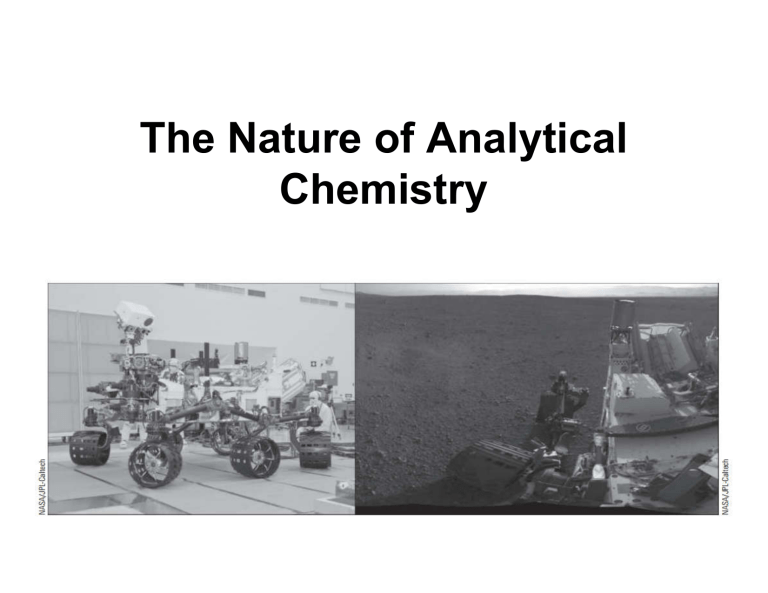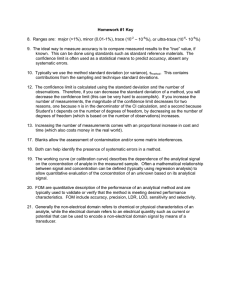
The Nature of Analytical Chemistry What is Analytical Chemistry? Analytical chemistry is a measurement science consisting of a set of powerful ideas and methods that are useful in all fields of science and medicine. • Qualitative analysis reveals the identity of the elements and compounds in a sample. • Quantitative analysis indicates the amount of each substance (analyte) in a sample. 2 What is Analytical Chemistry? Qualitative analysis is what. Quantitative analysis is how much. 3 The Role of Analytical Chemistry • Analytical chemistry is applied throughout industry, medicine, and all the sciences. • Quantitative analytical measurements also play a vital role in chemistry, biochemistry, biology, geology, physics, and the other sciences. • Many scientists devote much time in the laboratory gathering quantitative information about systems that are important and interesting to them. 4 The Role of Analytical Chemistry 5 6 Classifying Quantitative Analytical Methods The results of a typical quantitative analysis are computed from two measurements: 1) One is the mass or the volume of sample to be analyzed. 2) The second is the measurement of some quantity that is proportional to the amount of analyte in the sample, such as mass, volume, intensity of light, or electrical charge. 7 Classifying Quantitative Analytical Methods We classify analytical methods according to the nature of this final measurement. 1) Gravimetric methods determine the mass of the analyte or some compound chemically related to it. 2) Volumetric methods determine the volume of a solution containing sufficient reagent to react completely with the analyte. 8 Classifying Quantitative Analytical Methods 3) Electroanalytical methods involve the measurement of such electrical properties as voltage, current, resistance, and quantity of electrical charge. 4) Spectroscopic methods are based on measurement of the interaction between electromagnetic radiation and analyte atoms or molecules or on the production of such radiation by analytes. 9 Classifying Quantitative Analytical Methods Miscellaneous methods: • mass-to-charge ratio • rate of radioactive decay • heat of reaction • rate of reaction • sample thermal conductivity • optical activity • refractive index 10 Classifying Quantitative Analytical Methods 11 Flow Diagram Showing the Steps in a Quantitative Analysis 12 Picking a Method • One of the first questions to be considered in the selection process is the level of accuracy required. • A second consideration related to economic factors is the number of samples to be analyzed. • The complexity of the sample and the number of components in the sample always influence the choice of method to some degree. 13 Acquiring the Sample • Sampling involves obtaining a small mass of a material whose composition accurately represents the bulk of the material being sampled. • Sampling is frequently the most difficult step in an analysis and the source of greatest error. The final results of an analysis will never be any more reliable than the reliability of the sampling step. 14 Acquiring the Sample • A material is heterogeneous if its constituent parts can be distinguished visually or with the aid of a microscope. • An assay is the process of determining how much of a given sample is the material by its indicated name. • We analyze samples and we determine substances. 15 Processing the Sample • Under certain circumstances, no sample processing is required prior to the measurement step. • Under most circumstances, we must process the sample in any of a variety of different ways. • The first step in processing the sample is often the preparation of a laboratory sample. 16 Processing the Sample • Preparing a Laboratory Sample A solid sample is ground, mixed to ensure homogeneity, and stored for various lengths of time before analysis begins. Because any loss or gain of water changes the chemical composition of solids, it is a good idea to dry samples just before starting an analysis. Alternatively, the moisture content of the sample can be determined at the time of the analysis in a separate analytical procedure. 17 Processing the Sample • Preparing a Laboratory Sample Liquid samples are subject to solvent evaporation. If the analyte is a gas dissolved in a liquid, analyte must be kept inside a second sealed container to prevent contamination by atmospheric gases. Extraordinary measures, including sample manipulation and measurement in an inert atmosphere, may be required to preserve the integrity of the sample. 18 Processing the Sample • Replicate samples, or replicates, are portions of a material of approximately the same size that are carried through an analytical procedure at the same time and in the same way. • Replication improves the quality of the results and provides a measure of their reliability. • Quantitative measurements on replicates are usually averaged, and various statistical tests are performed on the results to establish their reliability. 19 Processing the Sample • Preparing Solutions: Physical and Chemical Changes Ideally, the solvent should dissolve the entire sample, including the analyte, rapidly and completely. The sample may require heating with aqueous solutions of strong acids, strong bases, oxidizing agents, reducing agents, or some combination of such reagents. It may be necessary to ignite the sample in air or oxygen or perform a high-temperature fusion of the sample in the presence of various fluxes. 20 Eliminating Interferences • Few chemical or physical properties of importance in chemical analysis are unique to a single chemical species. • Species other than the analyte that affect the final measurement are called interferences, or interferents. • An interference is a species that causes an error in an analysis by enhancing or attenuating (making smaller) the quantity being measured. 21 Eliminating Interferences • Techniques or reactions that work for only one analyte are said to be specific. Techniques or reactions that apply for only a few analytes are selective. • The matrix, or sample matrix, is all of the components in the sample containing an analyte. 22 Remaining Steps of A Typical Quantitative Analysis • Calibration and Measurement Ideally, the measurement of the property is directly proportional to the concentration. C A kX where k is a proportionality constant • Calculating Results Computing analyte concentrations are based on the raw experimental data collected in the measurement step, the characteristics of the measurement instruments, and the stoichiometry of the analytical reaction. 23 Remaining Steps of A Typical Quantitative Analysis • Evaluating Results by Estimating Their Reliability Analytical results are incomplete without an estimate of their reliability. 24 An Integral Role For Chemical Analysis: Feedback Control Systems • Chemical analysis is the measurement element in all of these examples and in many other cases. • The process of continuous measurement and control is often referred to as a feedback system, and the cycle of measurement, comparison, and control is called a feedback loop. 25 Feedback Control Systems 26




